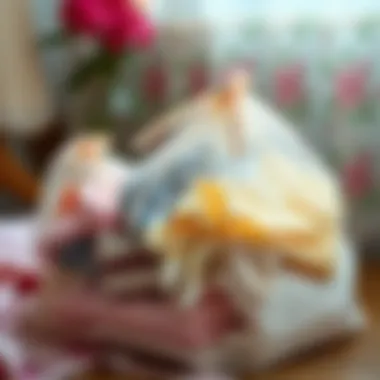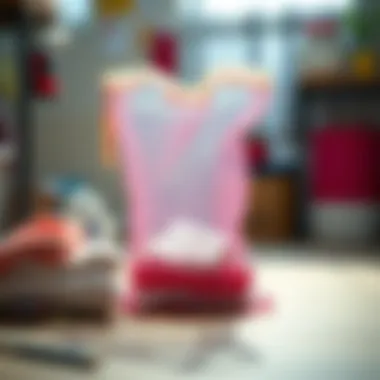Why Small Mesh Laundry Bags Are Essential for Delicates


Intro
In the realm of garment care, paying attention to details can make all the difference. Small mesh laundry bags are often overlooked tools that can safeguard delicate items during the washing process. From lacy blouses to soft cashmere sweaters, these bags serve a crucial purpose. While many may think they are just an extra expense, understanding their role can revolutionize the way we care for our garments.
When washing delicates, traditional methods can lead to wear and tear. From snagging on zippers to harsh tumbling in the dryer, these risks can degrade quality over time. Small mesh laundry bags provide a protective layer, acting as a buffer between garments and the harsh reality of washing machines. "Using a mesh bag is like giving your delicates a VIP treatment at the laundromat," one could say, ensuring they are kept safe from common hazards.
This article unfolds the many benefits of these small but mighty bags, diving into their design and materials, and how they contribute to the longevity of our favorite garments. It will also debunk some frequent myths surrounding their use and compare them to alternative solutions for laundry care.
As fashion enthusiasts crave quality over quantity, understanding the merits of small mesh laundry bags can empower consumers to make thoughtful choices, preserving the beauty and integrity of our cherished clothing.
Understanding Delicate Fabrics
Delicate fabrics are at the heart of many cherished garments, making them a focal point in the realm of clothing care. By comprehending what classifies as delicate, one can appreciate why special attention is necessary for preserving these pieces. Whether it's a soft silk blouse or a fine lace dress, understanding the nuances of such fabrics goes a long way in maintaining their form and function.
Characteristics of Delicate Fabrics
Delicate fabrics, generally characterized by their light weight and intricate structure, possess unique traits that differentiate them from more robust materials. Some typical features include:
- Fine Fibers: Fabrics like chiffon, silk, and lace are made from exceptionally fine threads that lend them their luxurious feel but also make them prone to damage.
- Sheer Quality: Many delicate textiles offer a sheer look, adding sophistication but requiring extra care to guard against snags and tears.
- Sensitivity to Heat and Moisture: Such materials often respond poorly to high temperatures and certain washing conditions, leading to shrinkage or alteration in texture.
Because of these characteristics, understanding how to properly care for delicate fabrics will help prevent premature wear and tear, thus extending the life of treasured items.
Common Types of Delicate Fabrics
Numerous fabrics fall under the delicate category, and each type requires a unique approach to maintenance. Here’s a rundown of some common delicate materials:
- Silk: Renowned for its softness and sheen, silk is often used in luxurious garments. However, mishandling can lead to fading and weakening.
- Chiffon: This lightweight, sheer material is often used in evening wear. Its loosely woven structure makes it vulnerable to tearing, especially in the wash.
- Lace: Often embellishing garments rather than making the entire piece, lace is intricate and delicate, necessitating careful treatment when cleaning.
- Satin: Smooth and glossy, satin is used frequently in formal wear but is sensitive to snags and requires gentle washing techniques.
- Tulle: Common in skirts and veils, tulle is another lightweight fabric that can easily become misshapen or torn if not handled with care.
Incorporating knowledge about these delicate types provides critical insight for garment care. Armed with this information, individuals can better navigate the complexities of washing, drying, and storing their delicate items, ensuring longevity and beauty.
"Understanding the characteristics and types of delicate fabrics is the first step in effective garment care."
The importance of recognizing these elements cannot be overstated, especially when considering the role of small mesh laundry bags in protecting these fragile textiles.
The Role of Laundry Bags
When it comes to caring for delicate garments, small mesh laundry bags play a critical role that cannot be overstated. These seemingly simple objects serve as an additional layer of protection during the laundry process, ensuring that fine fabrics maintain their integrity while navigating the rigors of washing machines. This section delves into their significance, detailing aspects such as the practical usages, the extensive benefits they provide to garment care, and considerations that anyone using laundry bags should keep in mind.
Purpose of Laundry Bags in Garment Care
The primary purpose of laundry bags revolves around their ability to shield delicate fabrics from harsh conditions.
- Reduction of Friction: During a typical wash cycle, garments can rub against each other and the machine drum, causing wear and tear on sensitive materials. A mesh bag effectively minimizes this friction, significantly extending the life of your delicate pieces.
- Prevention of Tangling: Garments like bras, lace tops, or anything with embellishments can easily get tangled and twisted. Using a small mesh laundry bag keeps these items separate, ensuring they emerge from the wash unscathed.
- Protection from Fasteners: Whether it’s buttons, zippers, or hooks, these features can wreak havoc on softer fabrics. Laundry bags can encase those fasteners, preventing them from snagging other garments.
- Easy Organization: The bags facilitate organization within the laundry process. You can sort garments by color, fabric type, or washing instructions, simplifying your laundry chores.
By keeping these purposes in mind, one can appreciate the crucial role the bags play, transforming laundry day from a potential disaster into a manageable chore.
How Laundry Bags Protect Delicate Items
Understanding how laundry bags protect delicate items requires a closer look at both their construction and functionality.
- Material Composition: Typically made from breathable mesh fabric, these bags allow water and detergent to reach all areas of the garment while providing a physical barrier against agitation and abrasion. This design drastically reduces the likelihood of fabric damage.
- Versatility Across Different Fabrics: Small mesh laundry bags work wonders not just for lingerie but also for other delicate fabrics like silk, chiffon, and certain knits. No matter what you’re washing—be it fine blouses or lace tablecloths—these bags adapt as excellent companions.
- Temperature Regulation: The design also helps regulate temperatures on delicate fabrics. Wool, for instance, can felt if subjected to high heat. In a bag, it maintains its shape and texture even under intense cycles.


"Laundry bags haven’t just become a luxury; they have turned into a necessity for preserving the integrity of garments."
In a world that often prioritizes efficiency over carefulness, using small mesh laundry bags serves as a wise compromise, ensuring that delicate items remain in pristine condition. It's the small details—like choosing the right laundry bag—that lead to significant differences in garment longevity. By addressing both protective and practical aspects, laundry bags undeniably enhance the entire laundering experience.
Design and Material Composition
Understanding the intricacies of small mesh laundry bags is crucial for anyone invested in the care and maintenance of delicate fabrics. The thoughtful design and composition of these bags play an essential role in preserving the integrity of your garments. Focusing on the structural elements and choice of materials can greatly enhance their effectiveness. Hence, it’s worth delving deeper into these aspects.
Features of Small Mesh Laundry Bags
Small mesh laundry bags are masterfully designed to cater specifically to delicate items. The key features that set them apart include:
- Ventilation: The mesh fabric allows for air circulation, which helps in thorough cleaning and drying. Moisture can escape, preventing musty odors.
- Durability: High-quality mesh is strong yet lightweight. This combination means that while the bag protects the contents, it won't add unnecessary weight.
- Variety of Sizes: Available in a variety of dimensions, these laundry bags accommodate everything from lace lingerie to more substantial delicate garments.
- Zippers and Closures: Many bags feature reinforced zippers or drawstrings to keep items secure during the wash. This characteristic ensures that nothing slips out during the rigorous action of a washing machine.
In practical terms, these features create a strong safeguard against the common realities of laundry day mishaps, ensuring that your delicate garments come out as pristine as they went in.
Materials Used in Manufacturing
When it comes to the materials used to craft small mesh laundry bags, manufacturers typically utilize textiles that can withstand frequent laundering while offering flexibility. Notable materials include:
- Polyester: A common choice due to its strength and resilience. It resists stretching and shrinking, providing a reliable home for your delicate items.
- Nylon: Known for its durability, nylon mesh is another great option. It balances lightness with robust performance. Plus, it dries quickly, making it perfect for regular use.
- Cotton: Though less common for traditional mesh laundry bags, organic cotton bags are gaining popularity. Eco-friendly and gentle on fabrics, they can be an attractive option for those interested in sustainable choices.
Employing these materials not only affects the longevity of the bag but also the care that it provides for its contents. The right mix ensures that delicate items are cleaned without compromising their fabric structure.
Comparative Analysis of Various Fabrics
Delicate fabrics such as silk, chiffon, and lace require special handling, making the choice of laundry bags paramount. A comparative analysis reveals how different bag materials stack up:
- Polyester vs. Nylon: Both are durable, but polyester tends to be more UV resistant, making it less prone to fading if left in the sun. However, nylon shines in terms of flexibility and drying speed.
- Nylon vs. Cotton: While nylon offers water resistance, cotton tends to be more breathable. The best choice depends on whether the emphasis is on stain resistance or gentleness on fabrics.
- Specialty Bags for Specific Items: Sometimes, specialty laundry bags are tailored for specific fabrics—like those specially designed for wool or silk—ensuring every garment receives personalized care.
Understanding the interplay between these different materials and their characteristics can inform your purchase decision, ultimately leading to better fabric care and longevity.
"A well-chosen laundry bag can mean the difference between a long-lasting garment and a wardrobe casualty."
By thoroughly considering design features and material composition, you can significantly enhance the life and beauty of your delicate fabrics. This foundational knowledge sets the stage for making wise decisions when it comes to garment care.
Choosing the Right Laundry Bag
Selecting an appropriate laundry bag may seem trivial, but it can actually make a world of difference when it comes to preserving your delicate garments. When we consider delicate fabrics, the need for proper care becomes paramount. The right laundry bag protects these garments from potential damage in the washing machine. Here’s how to make a sound choice in laundry bags that keep your beloved pieces looking their best.
Size Considerations for Different Garments
Size does matter—especially when it comes to laundry bags. Choosing a bag too small can lead to crowded fabrics that rub against each other, creating snags or piling. On the other hand, a bag that's too large may not provide the proper containment required to keep delicate items secure. Here are some tips to consider:
- Know Your Garments: Before purchasing a laundry bag, take stock of the types of delicate items you frequently wash. Are they lacy bras, soft blouses, or intricate nightgowns? Each type has a unique size and shape that can dictate the kind of laundry bag you need.
- Opt for Depth: For longer garments such as dresses or skirts, you might prefer a deeper bag to accommodate their length without crumpling or folding. This will help prevent stress on stitching and seams.
- Multiple Bags: Consider getting several bags in varied sizes. That way, you can easily group items: smaller bags for undergarments, medium ones for blouses, and larger bags for dresses. This not only keeps everything organized but helps you maintain the right balance during washes.
Mesh Density and Fabric Protection
When it comes to protective qualities, the density of the mesh in your laundry bag plays a crucial role. Thin mesh may seem ideal for breathability, but it often lacks the necessary containment that delicate garments require while being tossed around in the wash. Here’s what to keep in mind:
- Tight Weave for Delicate Fabrics: Look for bags made from tightly woven mesh. This construction ensures that nothing can snag through the holes, keeping your delicate items safe.
- Balance Between Protection and Agitation: While you want a gentle wash for delicate items, it’s also important to ensure some level of agitation. A bag with appropriate mesh density allows water and detergent to circulate freely while reducing friction against the fabric.
"Choosing a laundry bag is not about convenience; it's about protecting the investment you've made in your wardrobe."


- Avoid Too Much Thickness: While denser bags provide better protection, too much thickness may prevent the items from getting cleaned effectively. A balance is key here; look for bags that offer substantial protection without compromising cleaning efficiency.
By understanding size considerations and mesh density, you’ll be more equipped to make an informed choice when selecting the right laundry bags. Making the right selection enhances garment care, prolonging the life of your favorite delicate items.
Best Practices for Using Laundry Bags
Using small mesh laundry bags is a simple yet effective practice that can greatly enhance the care of delicate garments. It’s crucial to understand the nuances of how to utilize these bags properly. This section will delve into best practices that every individual handling delicate fabrics ought to be aware of. Knowing how to prepare your clothes, how to load the bags correctly, and which wash cycle to choose plays a significant role in maintaining the quality and lifespan of these cherished items.
Prepping Clothes Before Washing
Taking time to prep your clothes before tossing them into the washing machine might feel like a chore, but it yields considerable benefits for delicate fabrics. First off, always inspect your garments for any loose buttons, embellishments, or stray threads. These small features can become caught or damaged during a wash cycle, leading to irreversible harm.
- Turn garments inside out: This minimizes friction on the outer surface which protects delicate fibers from abrasion.
- Remove any items from pockets: Coins or bits of paper can be troublesome, damaging both your clothes and the machine.
- Use gentle detergent: Opt for formulas specifically made for delicates. Harsh chemicals can weaken fibers over time.
By preparing your clothes beforehand, you effectively mitigate potential damage that could occur, paving the way for a more successful wash.
Loading the Laundry Bag Properly
Loading the laundry bag isn’t just about cramming as much as possible into it. Overloading is a common mistake that can lead to increased wear and tear on your delicate garments. Adhere to the following pointers:
- Don’t overcrowd the bag: Each piece should have enough room to move around freely. This prevents items from snagging each other and reduces friction.
- Group similar fabrics: Washing silk with cotton, for instance, can lead to unfortunate outcomes. Grouping items by material ensures they receive the same level of care during washing.
- Secure zippers and clasps: Always close zippers and fasten clasps before placing them inside the bag. This reduces the risk of anything getting tangled.
Proper loading not only protects your delicates but also ensures a more efficient wash cycle.
Selecting the Right Wash Cycle
Choosing the appropriate wash cycle is just as important as the previous steps. Delicates require gentler handling, and many modern washing machines include specific settings for them. When selecting a wash cycle, consider these elements:
- Opt for the gentle or delicate cycle: These cycles use slower spin speeds and less agitation, which means your garments are less likely to suffer damage.
- Cold water is a friend: Warm or hot water can cause delicate fabrics to shrink or lose color. Sticking with cold water preserves the integrity of the garment.
- Keep it simple: Sometimes, less is more. If in doubt, choose a shorter cycle to reduce tumbling and friction.
Debunking Myths about Laundry Bags
When it comes to garment care, small mesh laundry bags are often misunderstood. Many people have misconceptions about their effectiveness, thinking they are just an unnecessary add-on to laundry routines. Debunking these myths is essential for anyone who wants to get the most out of their delicate garments. As we delve into this section, we will address specific elements that show the real benefits and considerations that come with using laundry bags to protect our favorite items.
Common Misconceptions Addressed
- Laundry Bags Only for Expensive Items
Some believe that small mesh laundry bags are only for items that cost a pretty penny. The truth is, every delicate fabric—be it an expensive silk blouse or a more affordable lace piece—can benefit from the added protection that a laundry bag provides. These bags help maintain the structural integrity of any delicate item, prolonging its life regardless of its price point. - They Don’t Make a Difference
A widespread belief is that simply tossing delicates in the wash will not significantly harm them. However, the scuffing and tangling that can happen during a wash cycle can cause irreversible damage to finer fabrics. A small mesh laundry bag helps mitigate this by providing a cushioned environment, keeping items separate and reducing agitation from being tossed around with heavier garments. - One Size Fits All
Some people think one standard laundry bag will handle all their delicate items. That’s like saying one tool can fix every problem. Various fabrics require different levels of protection, and investing in bags of various sizes and mesh density can significantly improve their effectiveness. For instance, thin lace needs ultra-fine mesh while thicker knits can do well with regular mesh bags. - Only Necessary for Machine Washing
Many believe small mesh laundry bags are just for machine washing. But they also serve a purpose during hand-washing cycles too. By using a bag, it helps contain items, making them easier to manage and rinse without the risk of stretching or snagging against rough surfaces.
Scientific Evidence Supporting Their Use
The conversation around the effectiveness of small mesh laundry bags isn't just based on hearsay; there's science behind it. Studies suggest that fabrics experience less friction during washing when paired with appropriate protective gear. Specific trials have indicated that garments housed within mesh bags suffer up to 50% less abrasion, which is vital for maintaining their look and feel over time.
Small mesh laundry bags can significantly prolong the life of delicate fabrics, preventing wear and tear from a regular wash cycle.
Furthermore, research has shown that the mesh density plays a crucial role in allowing adequate water and detergent circulation while still offering protection. Using bags with appropriate mesh size ensures proper detergent dissolution and rinsing, which are critical for cleaning while preserving the integrity of fabrics.
In practices observed by textile professionals, those who use laundry bags report higher satisfaction rates with their garments’ longevity and appearance compared to those who skip them. This evidence underscores the necessity of moving past common misconceptions and fully embracing the proactive measures that small mesh laundry bags provide.
Alternatives to Small Mesh Laundry Bags
When it comes to taking care of delicate garments, small mesh laundry bags often take the spotlight. However, various alternatives exist that can also safeguard your cherished items. Understanding these alternatives isn’t just about exploring other options; it’s about ensuring consistent and effective care for your valuable fabrics. By examining the choices available and understanding their unique benefits, users can find solutions that best fit their needs and lifestyles.


Other Products for Delicate Care
In the realm of laundry care, there are several products you might consider that offer protection for delicate fabrics, often with a different approach than mesh laundry bags. Here are a few noteworthy alternatives:
- Silk Washing Bags: Designed specifically for silk or other fragile materials, these bags often add an extra layer of padding and protection while allowing water flow through.
- Pillowcases: An old-school hack is to place delicate items inside a pillowcase. Secure it with a rubber band. This method is great if a laundry bag isn’t at hand. It offers some protection from the agitator during the wash cycle while letting you use what you might already have at home.
- Wool Dryer Balls: While these balls are typically used for drying, they can help reduce friction and snagging during the drying process. They are particularly beneficial when washing items that tend to cling or get tangled.
- Mesh Wash Bags of Different Shapes: Depending on what you’re washing, having different shaped bags, such as bra wash bags or larger garment bags, can ensure better coverage and protection of specific types of delicate clothing.
Comparing Effectiveness with Different Solutions
Every product comes with its own set of advantages and limitations. When weighing the effectiveness of alternatives to small mesh laundry bags, one should consider essential factors:
- Protection Level:
- Convenience:
- Durability:
- Cost vs. Longevity:
- Small mesh laundry bags provide a breathable environment that shields delicate fabrics from wear and tear. However, other products also offer protective qualities but may lack breathability.
- Pillowcases are readily available, but they may not keep items as contained as a dedicated laundry bag. On the flip side, specialized bags can be more expensive and may require additional care.
- Some alternatives, like silk wash bags, could wear out faster than sturdier mesh bags, making it crucial for users to analyze how often they wash delicate items.
- Spending more on a high-quality mesh laundry bag might save you money in the long run by preserving your garments better than cheaper alternatives that might wear out faster or fail to offer adequate protection.
In summary, exploring options beyond small mesh laundry bags can lead to valuable discoveries about garment care and how to maintain clothes in the best condition possible.
Understanding these alternatives can enhance the overall laundry experience. Ultimately, whether you choose to stick with mesh bags or experiment with different care solutions, the aim should always be the well-being of your delicate fabrics. Armed with this knowledge, you can confidently make decisions that suit your laundry needs.
Environmental Considerations
As our world becomes increasingly conscious of environmental issues, the significance of small mesh laundry bags extends beyond merely preserving delicate fabrics. These bags serve as a microcosm for discussing broader environmental considerations in fabric care, particularly concerning sustainability and the responsible use of resources. By integrating these small but mighty tools into our laundering practices, we can mitigate adverse impacts on the environment while protecting our cherished garments.
Sustainable Choices in Fabric Care
The journey toward sustainability in fabric care begins with a mindful selection of laundry products. Small mesh laundry bags epitomize this principle by advocating for longevity and proper maintenance of delicates. Unraveling this concept doggedly shows that choosing the right material for these bags can minimize disposable waste in landfills, promoting the notion of reuse over disposability.
- Materials Matter: Opt for laundry bags made from recycled materials or biodegradable fabrics. Not only do they serve the practical purpose of protecting delicates, but they also align with eco-friendly practices. This choice signifies a step away from traditional plastics that plague our planet.
- Energy Efficiency: By utilizing laundry bags, you can extend the life of delicate garments, thus reducing the frequency of purchases. Fewer garments mean less waste and lower energy consumption during manufacturing processes.
"To care for the earth is to care for ourselves. Protecting our delicate items is only part of the equation."
Impact of Synthetic vs. Natural Fibers
While the selection of laundry bags plays a role, the fabrics themselves—both synthetic and natural—further complicate our environmental discussion. It's necessary to understand the benefits and drawbacks of each to make informed choices about garment care.
- Natural Fibers: Fabrics like cotton, linen, and wool boast biodegradability, which means, at the end of their life cycle, they can break down naturally without leaving behind toxic residues. However, the production of natural fibers often involves high water usage and chemical fertilizers.
- Synthetic Fibers: Fabrics such as polyester and nylon, while durable and often tear-resistant, can be detrimental to the environment as they are derived from petroleum-based sources. The process of washing these materials can result in microplastic release into waterways, thereby impacting marine life.
Ultimately, adopting small mesh laundry bags allows users to make more sustainable choices. By effectively washing and caring for these fabrics, whether natural or synthetic, individuals can contribute to a healthier planet. Understanding the differences between the fabric types can help consumers navigate their choices better, leading to improved garment care and environmental impact.
The End
Summarizing Key Takeaways
To grasp the significance of these laundry bags fully, consider the following key takeaways:
- Protection Against Damage: Small mesh laundry bags prevent snagging, stretching, and tangling that can occur during washing. Delicate items kept in these bags are less likely to suffer wear and tear from contact with other clothing.
- Reduction of Friction: The mesh provides a gentle buffer that reduces friction between delicate fabrics and rougher items, preserving their integrity.
- Ease of Use: Laundry bags simplify the sorting process, allowing for efficient washing of multiple items without the worry of damaging them.
- Environmentally Friendly: Using small mesh bags improves fabric longevity, reducing the frequency of replacements, which is a plus for the planet.
- Versatility: Besides laundry, these bags can be used for storage, travel, or organizing items, showcasing their multifunctional nature.
Future Trends in Laundry Accessories
Looking ahead, the landscape of laundry accessories is poised for some exciting changes. Here are a few trends to keep an eye on:
- Eco-Friendly Materials: As the push for sustainability grows, manufacturers are likely to innovate using biodegradable and sustainable fabrics for laundry bags.
- Smart Technology: With the advent of “smart” home appliances, we might see laundry bags equipped with sensors or tags that communicate fabric care instructions directly to washing machines.
- Customization Options: Increasing personalization of laundry bags—different colors, sizes, and even monogramming—may become popular as consumers seek to express their individuality.
- Health and Safety Features: In light of recent health concerns, bags designed with antimicrobial or antibacterial properties could become a preferred choice for anxious consumers.
In sum, small mesh laundry bags serve an essential function in garment care, combining practicality with innovation. Their proper use will not only enhance the life of delicates but also align with growing trends in sustainability and smart home integration. By incorporating these bags into your laundry routine, you’re investing not just in your wardrobe, but also in a more conscious and informed approach to fashion care.















